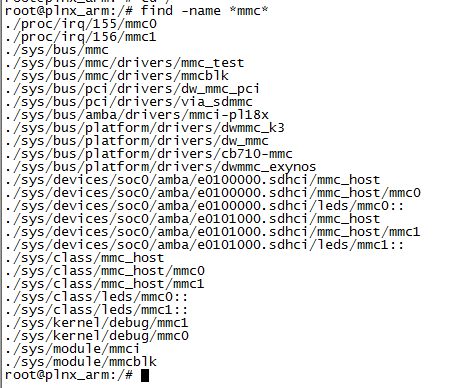我用zynq7000,在uboot下能找到emmc设备也能操作,但内核起来后在/dev目录下就没有emmc设备了。我怀疑是设备树的问题,也没有借鉴的,不清楚怎么修改,也不晓得是不是其他什么原因引起的。我内核是通过TFTP启动的。感谢大佬们提供思路与意见!

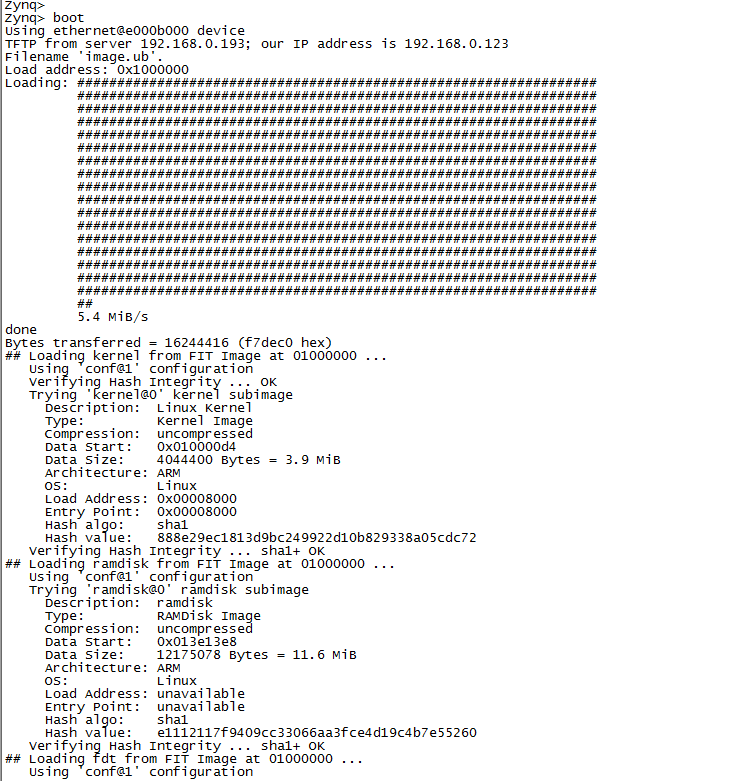
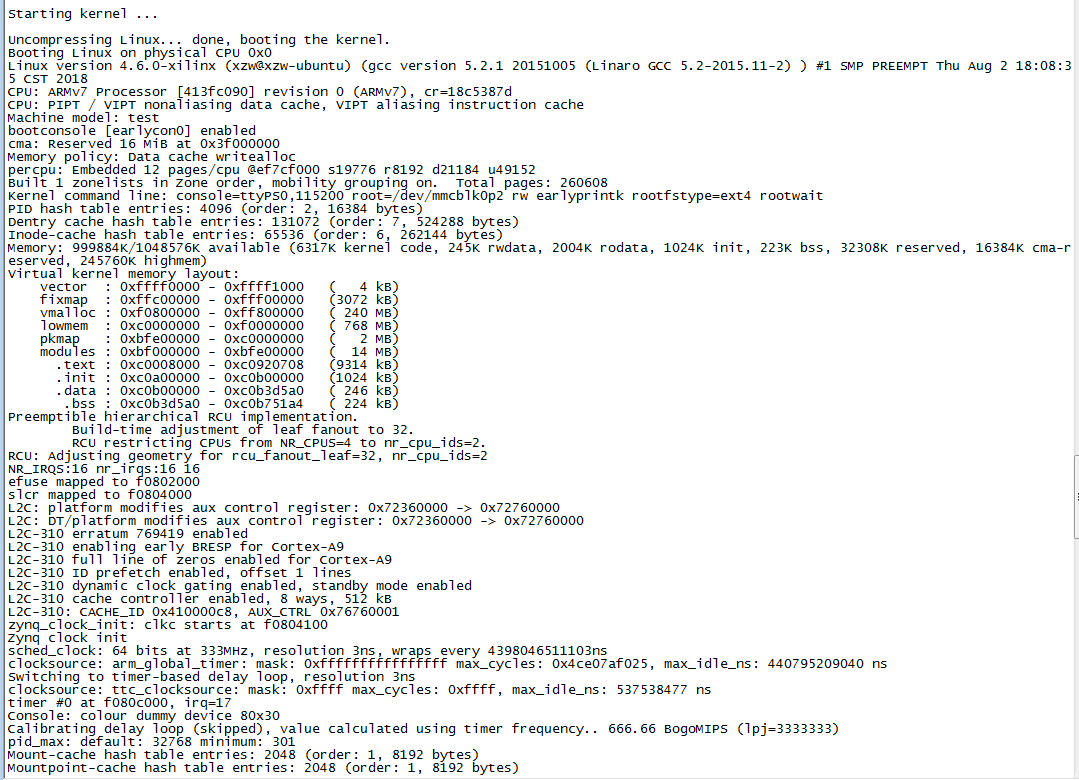

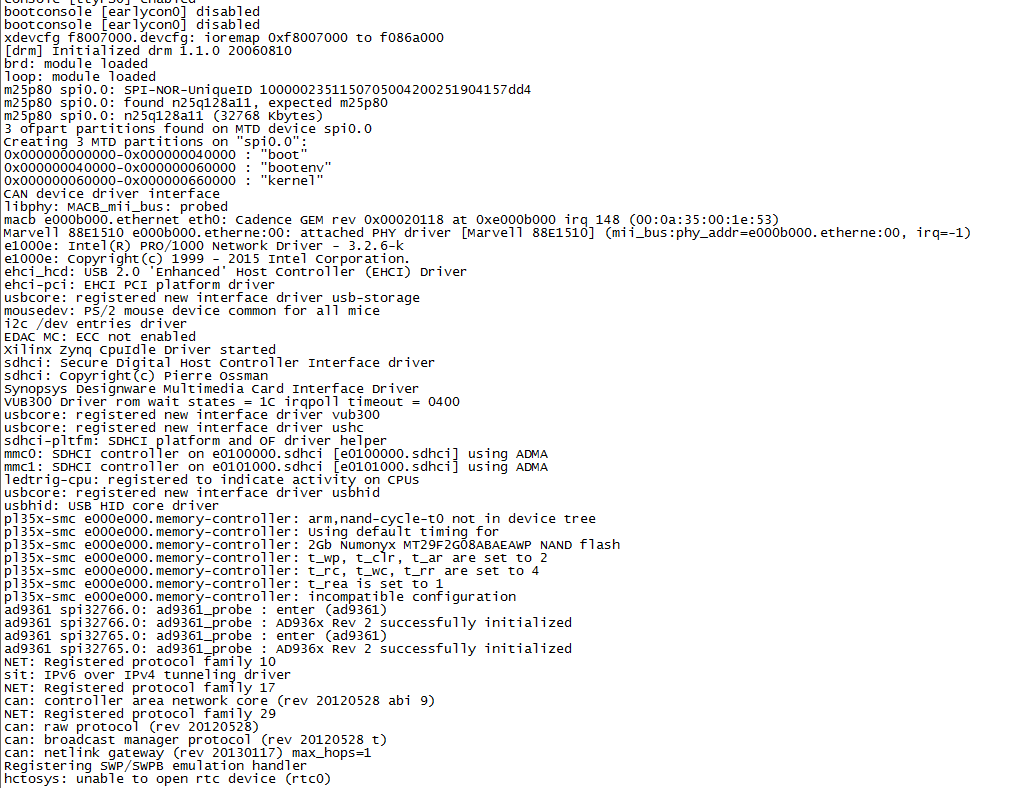
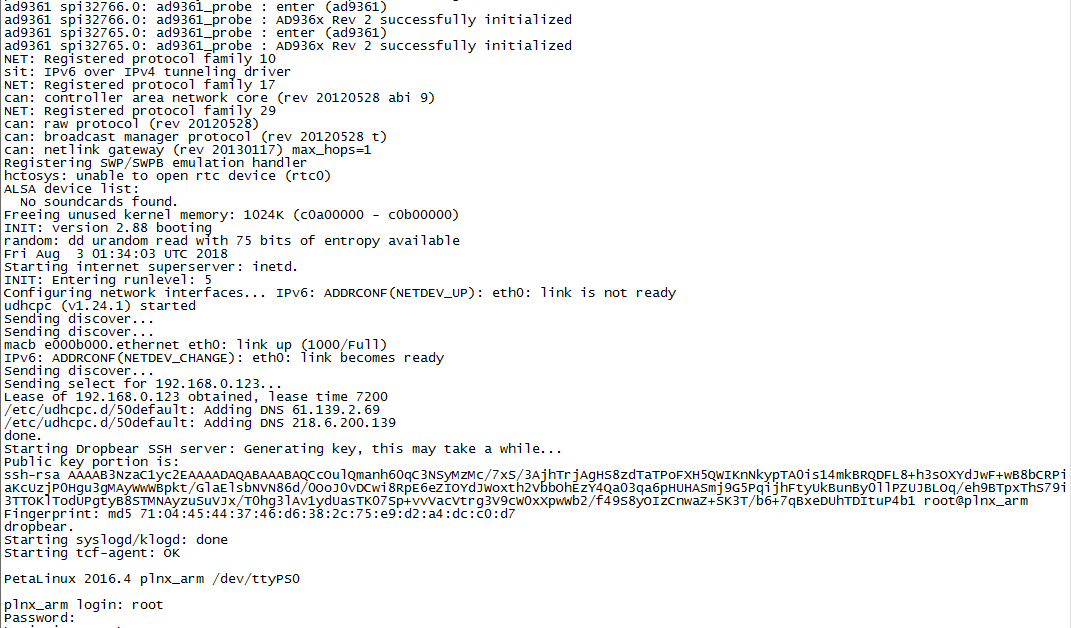
这里面也有mmc
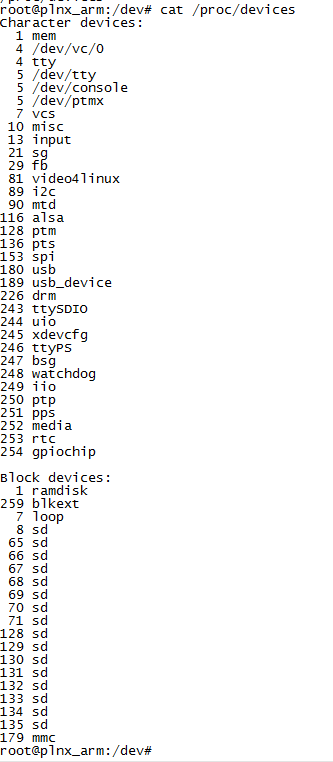
但/dev下面没有

这下面是我的部分设备树:
#address-cells = <0x1>;
#size-cells = <0x1>;
compatible = "xlnx,zynq-7000";
model = "test";
chosen {
bootargs = "console=ttyPS0,115200 root=/dev/mmcblk0p2 rw earlyprintk rootfstype=ext4 rootwait";
linux,stdout-path = "/amba@0/uart@E0001000";
//bootargs = [00];
//stdout-path = "serial0:115200ns";
};
aliases {
serial0 = "/amba/serial@e0000000";
ethernet0 = "/amba/ethernet@e000b000";
spi0 = "/amba/spi@e000d000";
};
memory {
device_type = "memory";
reg = <0x0 0x40000000>;
};
cpus {
#address-cells = <0x1>;
#size-cells = <0x0>;
cpu@0 {
compatible = "arm,cortex-a9";
device_type = "cpu";
reg = <0x0>;
clocks = <0x1 0x3>;
clock-latency = <0x3e8>;
cpu0-supply = <0x2>;
operating-points = <0xa2c2a 0xf4240 0x51615 0xf4240>;
};
cpu@1 {
compatible = "arm,cortex-a9";
device_type = "cpu";
reg = <0x1>;
clocks = <0x1 0x3>;
};
};
....................
cache-controller@f8f02000 {
compatible = "arm,pl310-cache";
reg = <0xf8f02000 0x1000>;
interrupts = <0x0 0x2 0x4>;
arm,data-latency = <0x3 0x2 0x2>;
arm,tag-latency = <0x2 0x2 0x2>;
cache-unified;
cache-level = <0x2>;
};
memory-controller@f8006000 {
compatible = "xlnx,zynq-ddrc-a05";
reg = <0xf8006000 0x1000>;
};
................
spi@e000d000 {
clock-names = "ref_clk", "pclk";
clocks = <0x1 0xa 0x1 0x2b>;
compatible = "xlnx,zynq-qspi-1.0";
status = "okay";
interrupt-parent = <0x3>;
interrupts = <0x0 0x13 0x4>;
reg = <0xe000d000 0x1000>;
#address-cells = <0x1>;
#size-cells = <0x0>;
is-dual = <0x0>;
num-cs = <0x1>;
flash@0 {
compatible = "micron,m25p80";
reg = <0x0>;
#address-cells = <0x1>;
#size-cells = <0x1>;
spi-max-frequency = <0x2faf080>;
partition@0x00000000 {
label = "boot";
reg = <0x0 0x40000>;
};
partition@0x00040000 {
label = "bootenv";
reg = <0x40000 0x20000>;
};
partition@0x00060000 {
label = "kernel";
reg = <0x60000 0x600000>;
};
};
};
memory-controller@e000e000 {
#address-cells = <0x1>;
#size-cells = <0x1>;
status = "okay";
clock-names = "memclk", "aclk";
clocks = <0x1 0xb 0x1 0x2c>;
compatible = "arm,pl353-smc-r2p1";
interrupt-parent = <0x3>;
interrupts = <0x0 0x12 0x4>;
ranges;
reg = <0xe000e000 0x1000>;
flash@e1000000 {
status = "okay";
compatible = "arm,pl353-nand-r2p1";
reg = <0xe1000000 0x1000000>;
#address-cells = <0x1>;
#size-cells = <0x1>;
};
flash@e2000000 {
status = "okay";
compatible = "cfi-flash";
reg = <0xe2000000 0x2000000>;
#address-cells = <0x1>;
#size-cells = <0x1>;
};
};
....................
sdhci@e0100000 {
compatible = "arasan,sdhci-8.9a";
status = "okay";
clock-names = "clk_xin", "clk_ahb";
clocks = <0x1 0x15 0x1 0x20>;
interrupt-parent = <0x3>;
interrupts = <0x0 0x18 0x4>;
reg = <0xe0100000 0x1000>;
broken-adma2;
xlnx,has-cd = <0x1>;
xlnx,has-power = <0x0>;
xlnx,has-wp = <0x1>;
};
sdhci@e0101000 {
compatible = "arasan,sdhci-8.9a";
status = "okay";
clock-names = "clk_xin", "clk_ahb";
clocks = <0x1 0x16 0x1 0x21>;
interrupt-parent = <0x3>;
interrupts = <0x0 0x2f 0x4>;
reg = <0xe0101000 0x1000>;
broken-adma2;
xlnx,has-cd = <0x1>;
xlnx,has-power = <0x0>;
xlnx,has-wp = <0x0>;
};
slcr@f8000000 {
#address-cells = <0x1>;
#size-cells = <0x1>;
compatible = "xlnx,zynq-slcr", "syscon", "simple-mfd";
reg = <0xf8000000 0x1000>;
ranges;
linux,phandle = <0x7>;
phandle = <0x7>;
clkc@100 {
#clock-cells = <0x1>;
compatible = "xlnx,ps7-clkc";
fclk-enable = <0x3>;
clock-output-names = "armpll", "ddrpll", "iopll", "cpu_6or4x", "cpu_3or2x", "cpu_2x", "cpu_1x", "ddr2x", "ddr3x", "dci", "lqspi", "smc", "pcap", "gem0", "gem1", "fclk0", "fclk1", "fclk2", "fclk3", "can0", "can1", "sdio0", "sdio1", "uart0", "uart1", "spi0", "spi1", "dma", "usb0_aper", "usb1_aper", "gem0_aper", "gem1_aper", "sdio0_aper", "sdio1_aper", "spi0_aper", "spi1_aper", "can0_aper", "can1_aper", "i2c0_aper", "i2c1_aper", "uart0_aper", "uart1_aper", "gpio_aper", "lqspi_aper", "smc_aper", "swdt", "dbg_trc", "dbg_apb";
reg = <0x100 0x100>;
ps-clk-frequency = <0x1fca055>;
linux,phandle = <0x1>;
phandle = <0x1>;
};
rstc@200 {
compatible = "xlnx,zynq-reset";
reg = <0x200 0x48>;
#reset-cells = <0x1>;
syscon = <0x7>;
};
pinctrl@700 {
compatible = "xlnx,pinctrl-zynq";
reg = <0x700 0x200>;
syscon = <0x7>;
};
};
 发帖
发帖 与我相关
与我相关 我的任务
我的任务 分享
分享







